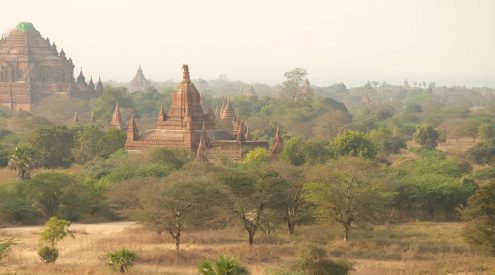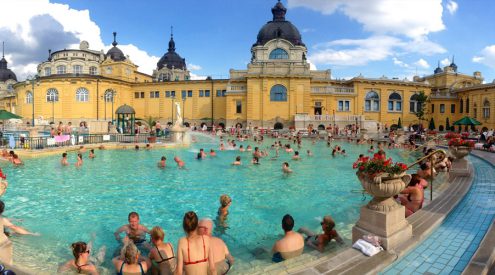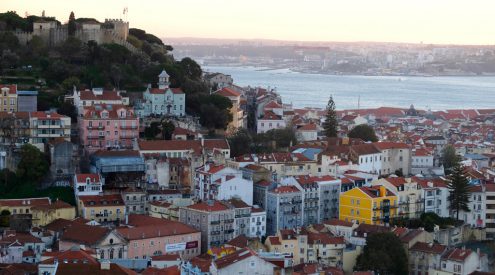On the road from Delhi to Agra we stopped to chat to peasant women shaping piles of cowpats into giant stacks of round wheels for heating and cooking fuel. Now that’s green energy for you. When I asked the guide how they get all the cows to take a dump in one spot, he laughed and explained they collect all the cow shit in the fields, then dry the “gobar” wheels in the sun. It’s one of the most unusual things I’ve stopped to photograph on the road anywhere. Even crap gets recycled in a poor country.
We overtake camel carts, bullock carts, goats and cows on the highway. You can see why the state of Uttar Pradesh, home to the capital of Delhi, is called “the cow belt”. Cows are holy in Hindu India. You never see beef on the menu – even at India’s MacDonald’s they serve chicken tikka burgers instead! Cows rule in India – they have right of way in the alleys, roads and freeways, blocking traffic – and munching on the verge. We’re carrying bags of biscuits and bananas to feed all the starving stray dogs.
Uttar Pradesh is the most densely populated state in India – home to over 170 million people and goodness knows how many cows. We passed miles and miles of bright yellow mustard fields in the rural countryside. At tourist stops along the freeway to Agra, there were signs up warning visitors “Don’t pay the monkey men and snake charmers (who blind the snakes) at intersections! It encourages abuse of animals!” When our bus pulled over for a rest stop, monkeys clambered all over the windows.
Six hours south of Delhi, we finally arrived in Agra, the capital of the Mogul empire before it was moved to Delhi. The world-famous Taj Mahal and Red Fort built by Emperor Akbar the Great are the two main tourist attractions. Here’s a hot tourist tip. It’s best to see the red fort late in the day when the red sandstone glows with the setting sun. Shah Jehan also had his palace here – but one of his sons seized power in 1658 and locked him up in a tower. He ended his days staring across the Yamuna river at the Taj Mahal he built as a monumental shrine to his late wife. But this epic love story has a happy ending – the Shah and wife are buried side by side at the Taj.
The Red Fort and palace used to be the home of the legendary peacock throne before it was plundered and carried off to Iran – or what was then Persia. The twin moats were once filled with crocodiles – and tigers patrolled between the massive walls! We enjoyed exploring the marble halls and mirror palaces. Watch out for the crack in the black marble throne caused by a cannon ball. The mosques in the fort are exquisite – the pearl mosque, the tiny gem mosque, the harem gardens and the mirror palace.
Emperor Akbar, the greatest mughal of all, was known for his religious tolerance – and for taking wives of muslim, Christian and other religious persuasions – so the fort is decorated with all the different religious symbols from crescents and crosses to stars of David! He even lifted the tax on pilgrims – though we had to pay to get into the fort and Taj. Fortunately entry is relatively inexpensive – about US$5 – US$10.
I spotted old vines planted in the palace gardens. The guide told us how Emperor Akbar, the enlightened ruler who built the fort in the 16th century, ordered good soil to be brought all the way from Kashmir in the north to plant vines to make wine crushed underfoot by the concubines in his harem. According to legend, they kept him satiated with sweet wine to keep him happy – helped by “the genie in the bottle”.
We enjoyed watching all the cheeky monkeys, striped yellow squirrels and bright green parakeets which live in the red fort. While travelling through India we came across many domestic tourists who were very curious about foreign visitors. We were invited to join family photographs taken by locals at many attractions – and ended up in family albums all over the continent! They want to know where you’re from, why you came all this way, how much it cost you – and what you think of India!
We were the first to see the Taj Mahal the next day. We were at the front of the queue! Every day, thousands of tourists come to see the Taj Mahal, the most famous icon of India. I’d heard the Taj is at its most beautiful at sunrise when the rosy light reflects on all the white marble – so we got up at dawn and queued in the dark at 6am! The gatekeeper told us he had inherited the job from his father – and that they’ve opened and closed the gate for the last forty years. The old wooden doors set in the fortress walls are massive. Men and women queue separately for the security check – as well as “high value foreign tourists” and “Indian gents” (that’s what the sign said!)
Everyone asks “Why is there no-one else in your shots of the Taj! Did you get a private viewing?!” It just goes to show it’s the early bird who gets, well the Taj. We were up before all the postcard and souvenir touts! The Taj is a magnificent sight – the most extravagant monument ever built for love. Emperor Shah Jehan, one of the greatest mogul emperors, built it from 1631 to 1653 as a tomb and shrine to his second wife who died in childbirth while giving birth to his 14th child! It took 20 000 artisans and 200 000 labourers, who came from all over Europe and Asia, 22 years to build this massive marble monument on the banks of the Yamuna river.
Rudyard Kipling called the Taj Mahal “the embodiment of all things pure” – while Tagore, the Indian Nobel prize-winning poet, called it “a teardrop on the face of eternity.” The Taj is supposed to represent the garden of paradise with four rivers.
The perfect symmetry of this Unesco world heritage site is incredible. Everyone jostles to photograph its reflection in the pools and water channels which lead thru the ornamental gardens. The four minarets actually lean a little so they can withstand earthquakes – and still look absolutely straight to the naked eye. The Taj is famous for its translucent marble walls inlaid with thousands of semi-precious stones (mother of pearl to lapis lazuli, oryx and malachite) – and elaborate marble screens. You could spend hours lost exploring the Taj. It cost the Shah US$70m to build it by today’s values – around R500m. I wonder how his other wives felt! So where’s our tomb?
We visited one of the workshops where the descendants of the old Taj artisans inlay precious stones into marble furniture. Every handmade piece is marked with how many thousands of fragments of semi-precious stones were used. Some take one artisan months to make – and are priced accordingly. Our travelling companion, Cecelia Amory of Egypt & Beyond and Champion Tours – who organises spiritual tours to India – bought a beautiful coffee table for her home in Johannesburg – and carried it as hand luggage all the way back to South Africa. Cecelia calls the Taj “a fairytale castle”. She says it makes you reflect on your own life.
We were the first to see the Taj Mahal and the last to see the fort in Agra that day!
I flew from Johannesburg to India on Jet Airways (www.jetairways.com – call 0860 JETAIR). I was a guest of www.egyptandbeyond.co.za, 011- 6784777 and Intrepid Travel – see www.intrepidbundu.com, tel: 0861 146 873.
















